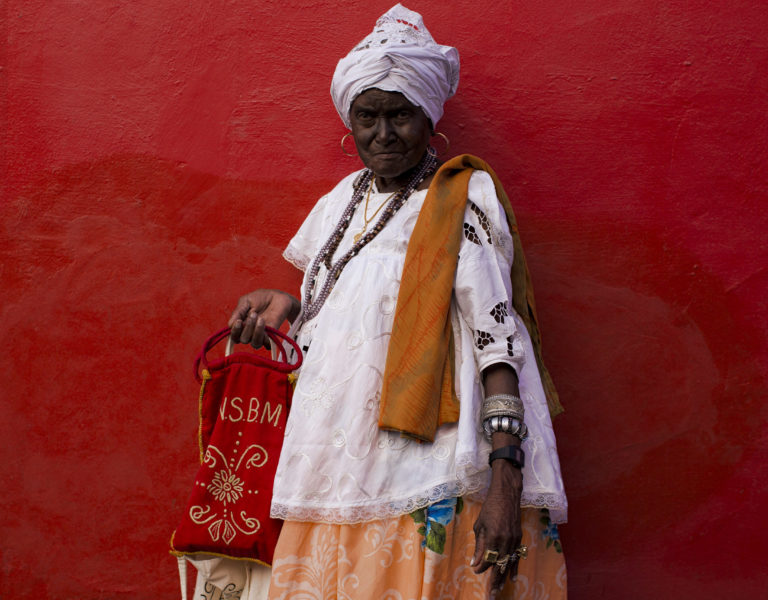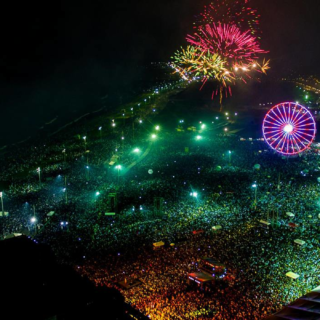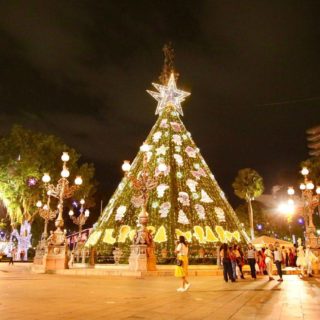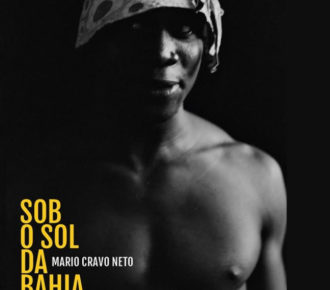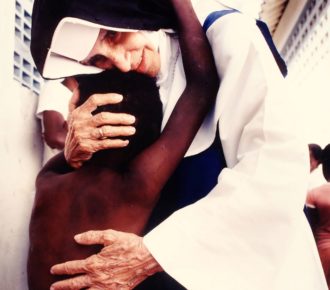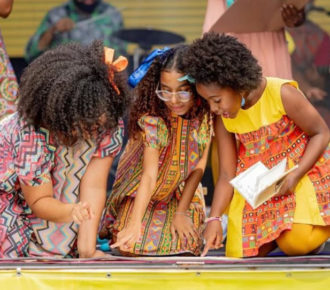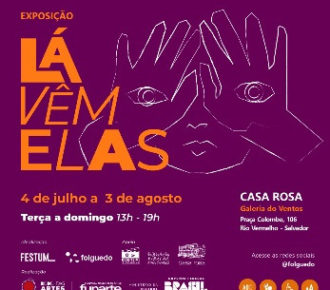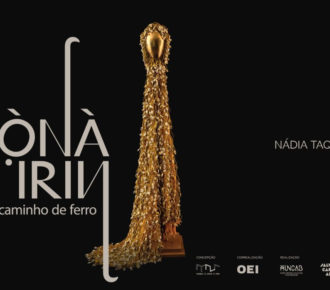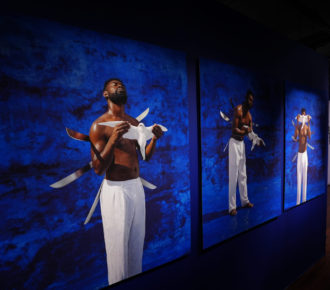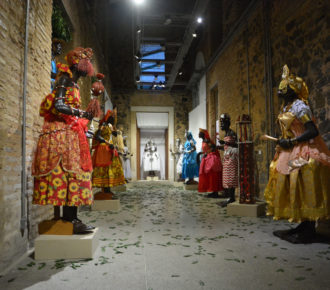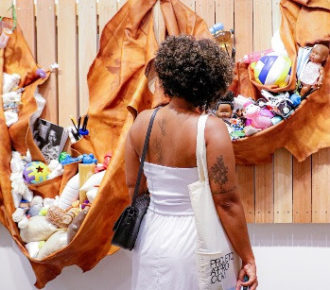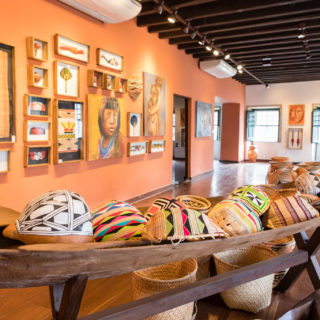
In Cachoeira, 120 km far from the Bahian capital, one of the most important celebrations in Bahia takes place
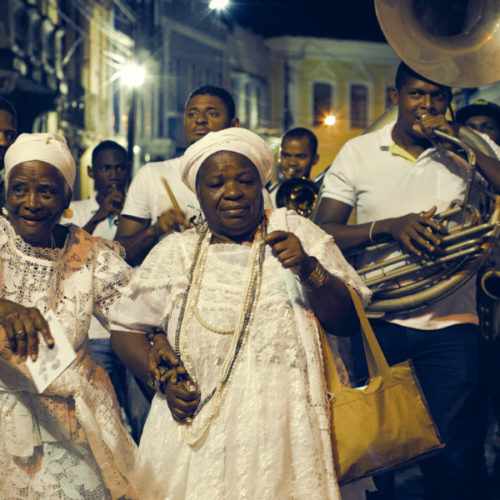
“People talk about slavery in such a natural way… but slavery was such a serious thing that black people didn’t believe, never believed in freedom, did you know that? After being enslaved, they never believed that they would have freedom. Black people only believed in true freedom after death. Therefore, Good Death. In that process, they asked to die, because they believed that, by dying, their spirits would go free to Africa. Death, for them, would be freedom. That’s why I say: Africa has always celebrated Death, Death is a state of freedom.” Valmir Pereira dos Santos, in a text contained in the book Nós Os Tincoãs.
The Feast of Our Lady of Good Death is one of the most important and interesting religious celebrations of Bahia. It takes place every year from August 13 to 17 in the city of Cachoeira, 120 km far from Bahia’s capital. The procession that goes through the streets of the city, with women dressed in gown and holding candles, is so grand that it attracts the attention of tourists, researchers, historians and photographers from all over the world, eager to know the local cultural identity in depth.
It is for this “Heroic City” and “Monument City” on the banks of the Paraguaçu River, in the Bahian Recôncavo, that we will take you. Much more than a party, the Order of Our Lady of the Good Death of Cachoeira, with all its peculiar functions, represents the resistance of black women in Brazil.
Photographer Vinicius Xavier makes documentary, contemporary, but above all political photography. His works are very intense and at the same time of an unsettling simplicity. They are the images that illustrate this article.
“In my work, I try to give voice through images to the people who really have value in Brazil, who are the people of the people, the people who are there fighting day by day, but fighting with affection, with respect for others, with unity”, explains Vinicius.
Intrinsically Linked to Life and Death
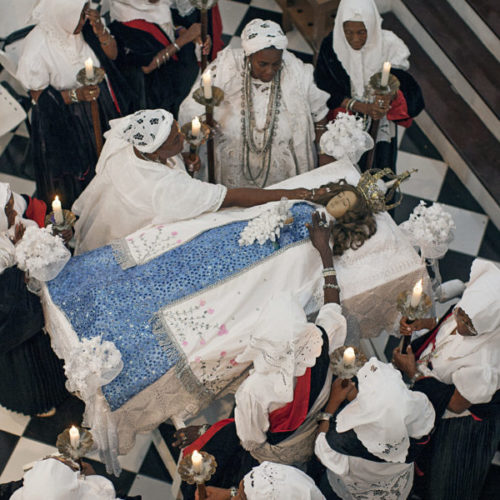
The symbols of the Good Death (cane, torch and coat of arms), clothing, food and rituals allude to this spiritual passage from Aiyê to Orun – in Yoruba, Aiyê is the earth or physical world, parallel to Orun, the spiritual world. According to the sisters of the Good Death, devotion to Our Lady of the Good Death arose linked to a request for the end of slavery made by Africans to Our Lady. The slaves called for protection and a peaceful death without agony. Soon, freed from the hardships of slavery, they celebrated the day of Our Lady of Glory with food and dancing at the brotherhood’s headquarters.
In Catholic tradition, the title Our Lady of Glory refers to the passage of the Virgin Mary from earthly life to heavenly life. The title of Our Lady of the Good Death is used to pray for us at the time of our death, upon which the eternal salvation of the soul depends. Much of the Catholic and Orthodox tradition believes in the Dormition of Mary, when Our Lady would have died and then been resurrected by Our Lord and taken to Heaven. These and other stories were taken from one of the only documents written about the party, the book Festas da Boa Morte – IPAC Notebook, 2.
The two interpretations come together when we go back in time. In the Roman Empire, beginning of the Christian era, is the embryo of Christian brotherhoods, called, however, pagans, because they were, at that time, marginalized by the authorities. Still according to the book, these organizations were true two-way streets, as they could serve as a “moderating instrument of social tensions”, but also legitimize for Africans and their descendants an institutional stamp beyond the religious sphere, making them political agents. By participating in Catholic practices, slaves could project themselves beyond the boundaries of labor.
According to Valmir Pereira dos Santos, musician, cultural agitator and active participant of the Brotherhood, the sisters of the Good Death are the mothers of the two ways of belonging that we can signal as syncretism and plurality. For him, they first go to the Church to search for religiosity as a cry of freedom of expression within society, to gain access to society. Then, in Candomblé’s terreiro, they seek African ancestry.
It is misleading to think that the Order of the Good Death reports to the Catholic Church, as is the case of the Brotherhood of the Rosary of Black Men. Also misleading to think that all the sisters are from the same nation, and therefore from the same candomblé. The Brotherhood has its own rituals and these are secret. This story is told by Adenor Gondim, one of the greatest photographers in the country who, since the 1980s, has been photographing aspects of Bahia’s culture, religiosity and daily life. In 1992, he began his research on the Order of the Good Death, which lasts to this day. Adenor not only photographed, but made friendships within the brotherhood. Also for this reason, he witnessed moments of intimacy of the sisters, conversations and sharing.
“Once I was in a room where some sisters talked about ‘their rituals’. They talked about using this or that herb: ‘I do it this way, but I do it that way’. That was a class. An exchange of indescribable richness”, says Adenor.
The Order of the Good Death was organized by eclectic ethnicities of Jeje, Ketu and Nagô origins making interethnic alliances, which always made these boundaries fluid in the convenience context.
The Church of Barroquinha in Salvador
Few people know, but there has been here in Salvador, since the nineteenth century, an exclusively female black devotion, built under the evocation of Our Lady of the Good Death, located in the Church of Barroquinha, where the Cultural Center Church of Barroquinha is today, in Praça Castro Alves. There also existed, since the eighteenth century, the Brotherhood of Our Lady of Martyrs.
According to historian Magnair Santos Barbosa’s study, this church was an important African stronghold in the 1820s. The church housed in the back, on leased land, Candomblé Àya Omi Àse Aìrá Intilé, considered the first urban terreiro in the city of Salvador. The Feast of the Assumption of the Virgin, the living face of Our Lady, celebrated on August 15 in that church, was considered “the busiest, most extensive and most ostentatious presentation of the processions ever held in Bahia”*. The men of the Martyrs and other black brotherhoods accompanied the processions of the Good Death, having the prominent places among the devout and socially ascending black women, for this reason called the “high party black women.”
When Salvador went into decay, added to the countless slave rebellions in the 1870s, a strong indication for social disruption, it motivated transits between the capital and its Recôncavo. The persecution also began, and many sisters, already free women, returned to Africa, others went to other states in Brazil and a significant part went to the Recôncavo.
Resistance of black women in Brazil
In the IPAC book, Magnair Santos Barbosa explains the importance of black women in the abolitionist movements in Brazil. With the transitional movement coming from the capital, in the city of Cachoeira, for example, the Order of the Good Death was installed in a house of number 41, on Matriz Street, nowadays Ana Nery Street, called Casa Estrela (Star House), because it had a five-pointed granite star on its sidewalk. This would be the core of the brotherhood. A large number of people circulated there, establishing religious, cultural, commercial and political relations.
Rising socially, these women were able to raise money (read: many kinds of valuable things) as urban workers to buy their own freedom or that of relatives and friends. A prominent African elite was then formed in Cachoeira, which moved among the wealthy classes of the region.
“Cross Dialogues”
In this journey, much has changed, including within the brotherhood structure. In the second half of the 1980s, a movement of the Catholic Church began to control the brotherhoods. Unable to hold their celebrations, the sisters were welcomed by the local Brazilian Church. Star House was no longer the brotherhood headquarters. Since the 1990s, the new headquarters was located at 13 de Maio Street and Largo D’Ajuda, in three houses that were donated to them. Adenor Gondim says that not only the Order of the Good Death but many secular brotherhoods have broken down, reducing membership and acting power.
Procession as an act of faith and devotion
After actually entering the Brotherhood’s historical and religious universe, we have made this guide for those who want to understand all the details of this party, day by day.
“General Alms”
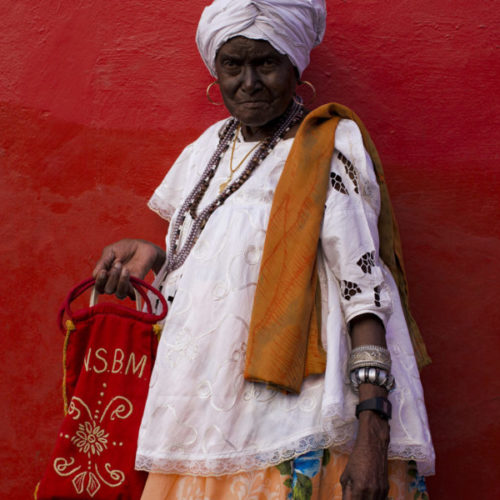
There is a party commission chosen in an annual election for the functions, which makes it impossible to concentrate power. The Perpetual Judge (maximum position currently open), the Provider, the Treasurer and the Registrar, each with their own duties, are responsible for every detail of the celebration.
Curiosity: It is known how many times and how many positions a sister has already taken up by looking at the horizontal white strips placed on the bars of her skirts. They may even repeat the same job several times, but they can never regress in the hierarchy.
One week after the election, which is one week before the party, the sisters go out through the main streets of Cachoeira, carrying red bags, embroidered with the symbol of the Brotherhood, going for alms in the houses, city center and free market. They are the “sisters with bags” who collect money for the party. Today there are four sisters who ask for “alms”, which is more of an obligation than a means of raising funds.
About 15 years ago, the artist and designer Goya Lopes made the “sisters with bags” skirts. Goya tells stories through prints and this is also the intention of the prints made on the sisters’ skirts.
“I print the fabric, which is usually the saint’s color of each one of the four sisters, I blend the saints (in a pattern). This year I made a detail of each orixá with its tool on the skirt to be even more customized. It is with this colorful clothing that they beg for alms, then they don’t go out again. Almost nobody knows that”, Goya explains.
The first day – August 13
6:30 pm – Departure of Our Lady of the Good Death’s body from the Chapel of Nossa Senhora D’Ajuda in procession through the city streets.
This is the day of the deceased sisters. This mass is the moment when they remember their names, praising their memories. Dressed in white – meaning a peaceful passage, a good death in the Afro-Brazilian religion – they go with candles on a pedestal to the Chapel of Our Lady D’Ajuda, where they pray and incense the place around the image of Our Lady’s body. Then they leave in procession carrying the image on a paso towards the Main Church – Our Lady of the Rosary Church. They stop only once, in front of the Star House (the first headquarters), when the saint turns around, demonstrating how important that place is.
Then the “White Supper” is served for Mother Mary. On a large table there are foods that don’t contain palm oil or pepper. Everything that goes on the table is white: rice, bread and different types of fish. It’s usually at Largo D’Ajuda.
Second day – August 14
7:00 pm – Our Lady Funeral Mass in the Chapel of Our Lady of the Good Death.
9:00 pm – Procession of Our Lady of the Good Death burial through the main streets of Cachoeira.
This is the moment of the “symbolic burial”, the dormition of Mary. With the image of Our Lady of the Good Death already in church, the sisters walk up in its direction, from the Brotherhood’s headquarters in the evening procession, carrying candles and dressed in a uniform: pleated black skirt and white sleeve blouse, white scarf at the waist and white slippers. Except for the “sisters with bags” who dress in festive white every day. During the Mass in the Chapel, the sisters take off their veils, stand before the Virgin as if asking for her intercession.
The festive ceremony ends with the sisters around the image, incensed by the priest, and the procession of Our Lady of Good Death, which runs through the main streets of the city until it arrives in the chapel of Our Lady of the Good Death.
The Day of Our Lady of Glory – August 15
5:00 am – Dawn with Fireworks
10:00 am – Solemn Mass of the Assumption of Our Lady of the Main Church of Our Lady of the Rosary.
11:00 am – Festive procession in honor of Our Lady of Glory and induction ceremony of the organizing committee 2019.
12:00 pm – Waltz and samba de roda at Largo D’Ajuda.
1:00 pm – Lunch of sisters, guests and community people at the brotherhood’s headquarters.
4:00 pm – Samba de roda at Largo D’Ajuda
The third festive day is the most expected: the day of Our Lady of Glory (or Our Lady of the Assumption). The procession leaves in the morning from the brotherhood’s headquarters, followed by the local Philharmonic. Carrying flowers in their hands, the sisters carry Our Lady of Glory’s Paso, assisted by some men. In the Main Church, the place is previously incensed by the priest.
The sisters celebrate the Assumption of Our Lady adorned with chains and necklaces, dressed in uniforms/gowns, with the back cloth on the red side (gala garment). They express the joy they feel with the elevation of Our Lady to heaven and the freedom from slavery.
Black clothing means mourning and the cloth (bioco) is a reference to Muslims. Everything they wear today comes from the time of the founders. It means the representation of a little bit of every people that has come, of every nation. The black side of the cloth means mourning and the red one the Glory of Our Lady, the blood, the heart, the joy.
On this day, the procession is longer, with the following itinerary: Star House, fair, pavilion of the Federal University of Recôncavo Baiano – UFRB, entrance of D. Pedro II Bridge, chapel of the Brotherhood’s headquarters (where they leave the saint), heading back to the Main Church. There happens the transfer of positions, with the new party committee taking office.
After finishing the procession at the Brotherhood’s headquarters, the sisters dance a waltz played by the local Philharmonic. The waltz means “party, saving life.”
August 16th
6:00 pm – A delicious stew followed by samba de roda at Largo D’Ajuda.
The act of giving food is equivalent to abundance and prosperity for the sisters.
“The culinary part, the stew that is offered to the community, the samba de roda, is when the sacred walks side by side with the profane. This thing of separating the sacred from the profane doesn’t exist in Bahia, this is a legend. That’s the way it is and there’s nothing wrong with that”, Vinícius Xavier explains.
August 17th
6:00 pm – Caruru followed by samba de roda and closing of the 2019 Party
After the last festive day, the sisters deliver fragrant flowers to the water as a gift, thus renewing their commitment to the continuity of life.
“The sisters, in their understanding of a peculiar cultural temporality, have mixed the orixás, voduns and caboclos from this heroic Cachoeiran land to the saints of the Church, to the mermaids, to the sacred serpents that give movement to the world and the earth, with the recipes of maniçoba , of leaf moqueca, pititinga, jenipapo liqueur, corn cake, corn lelê, and the abundant tabuleiro where acarajé rules. For everything flows and flows.” Raul Lody, Anthropologist and Museologist (taken from the IPAC book).
By Fernanda Slama
Content Coordinator
Books:
Nós os Tincoãs – realização da Sanzala Artística Cultural. Artistic Supervision and Direction of Mateus Hallelujah. Artistic and curatorial conception of Gringo Cardia.
Festas da Boa Morte – IPAC Notebook, 2 (Institute of Artistic and Cultural Heritage of Bahia and the Pedro Calmon Foundation.)
Notes:
Valmir Pereira dos Santos – musician, cultural agitator and active participant of the Order of the Good Death for 22 years.
Brotherhood of the Rosary of the Black Men – The Brotherhood of Our Lady of the Rosary of the Black Men was founded in the year 1685 and elevated to the rank of Third Order on July 2, 1899.
The study by historian Magnair Santos Barbosa is in the book: IPAC’s Notebook, 2 (Bahia Artistic and Cultural Heritage Institute and the Pedro Calmon Foundation).
* “The busiest, most extensive and most ostentatious presentation of the processions that have ever been held in Bahia” * / “Blacks of the high party” – Magnair Santos Barbosa mentions Pierre Verger’s book “Notícias da Bahia, 1850” (Currupio Publisher).

